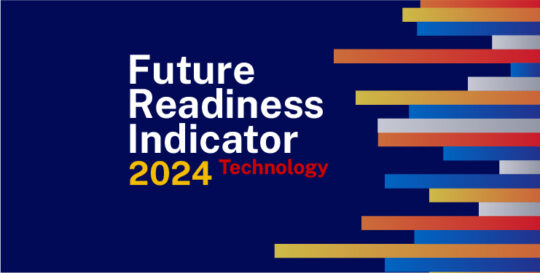IMD business school for management and leadership courses



By Howard Yu and the Center for Future Readiness
Future Readiness Indicator
By Howard Yu and the Center for Future Readiness
Masters of the AI stack dominate amidst a US-China tech decoupling
The Future Readiness Indicator 2025 highlights a global tech landscape in flux. The competitive edge belongs to those that are able to control every layer of the AI ecosystem – chips, cloud infrastructure, and the user interface, while legacy hardware firms fall behind.
- US companies – Nvidia (100,0), Microsoft (97,4), Alphabet (94,1) and Meta (91,4) – continue to dominate. Their competitive edge comes from mastery of the entire AI stack (infrastructure, software, and data), their financial strength, and their ability to shift their capabilities from within at the speed necessary to stay ahead.
- Some of the world’s most recognizable brands and regional powerhouses form the mid-tier (rank 5 – 19), including consumer-tech icons Apple and Amazon, chip leaders Samsung Electronics and TSMC, and enterprise specialist IBM. These firms excel in distinct domains but lag behind the top tier companies either in innovation velocity or ecosystem reach.
- Chinese tech companies (TenCent, Alibaba, Baidu and JD.com) have slipped amid sanctions (limiting their access to much needed AI hardware), tighter regulation, and a slower domestic economy. However, it would be premature to count China out; its companies command vast troves of user data and benefit from rapid, mass-market adoption.
- Alphabet climbed to third position (improving its score from 80.7 in 2024 to 94.1) overtaking Meta (91.4). Meta exemplifies the trap: $70-72bn in 2025 CapEx while Reality Labs loses $5.18bn annually and AI monetization lags infrastructure costs by 2:1. Meanwhile, Alphabet’s disciplined AI execution, investing $80bn whiles keeping margins above 30%, has made it the investor favorite. The lesson is stark: capital intensity without revenue connection is a wealth destroyer, not an innovation engine.
- Samsung transformed itself from a lagging supplier to a central player in the AI boom. It has experienced a meteoric rise from 20th place to seventh. Its persistence with its latest high-bandwidth memory chips paid off when, after several failed attempts, it passed Nvidia’s tough qualification tests.
- Companies that remain tethered to legacy hardware are finding it harder to adapt to the AI-centric world.
Future-ready companies and those falling behind
The 2025 Future Readiness Indicator for the technology sector reflects a market split into three distinct camps: those that have control over the full AI stack, those that are racing to catch up, and those tied to legacy hardware and struggling to find their place in the AI era.
1. The elite tier: The AI-first giants (Scores >90)
American companies still reign supreme with AI-first giants, Nvidia, Microsoft, Alphabet and Meta leading in every metric that matters. Nvidia tops the indicator with a perfect score of 100.0; the company remains the undisputed backbone of the AI era. Microsoft holds firm in second (94.0), while Alphabet’s relentless momentum pushes it into third (94.1), overtaking Meta Platforms (91.4) in fourth.
These four companies have grown revenues at an average 24% CAGR, far above the ~16% industry baseline. Together, they dominate every metric that matters – financial strength, innovation speed, and ecosystem control. Their competitive edge comes from mastery of the entire AI stack – infrastructure, software, and data. Nvidia’s CUDA ecosystem, Google’s TPUs, and OpenAI’s Broadcom chip partnership, show how control over infrastructure translates directly into margins and speed.
AI’s power doesn’t lie in automating steps; it lies in erasing friction. WeChat pioneered this years ago, letting users pay bills, book trips, and shop inside a single chat. OpenAI is now bringing that model westward: its Instant Checkout lets hundreds of millions of ChatGPT users complete purchases in one conversation. Alphabet’s AI Overviews, which boosted search queries by over 10%, and Microsoft’s Agent-to-Agent protocols are doing the same inside work and productivity tools. Apple’s on-device AI strategy, while privacy-focused, risks isolation from the broader cloud ecosystem.
The best companies know where to bet – and when to stop. Alphabet invested nearly $80bn in AI infrastructure while keeping margins above 30%. Alphabet managed what few tech giants do: expanding aggressively in AI without bloating costs or eroding profits. Its execution reinforced a new rule for the AI era: innovation must pay for itself. This disciplined, monetizable AI execution contrasts with Meta’s costly experiments: its Llama language models have become the world’s most-downloaded open-source AI, but have no clear revenue stream and Reality Labs, the metaverse division, continues to burn money at historic levels.
Microsoft, meanwhile, diversified across multiple AI partners instead of relying solely on OpenAI. Nvidia turned its relentless chip release cadence into a predictable growth engine.
2. The middle tier: Playing catch up (Scores >50 and <90)
This is where the action and the tensions lie. Spanning ranks five through 19; the mid-tier includes some of the world’s most recognizable brands and regional powerhouses. It’s a diverse mix: consumer-tech icons, chip leaders, and enterprise specialists.
Apple (87.7) and Amazon (86.2) complete the top six, though a distinct chasm separates them from the leading quartet. The first non-U.S. entrant is Samsung (80.0), which jumped from 20th to seventh place, having transformed itself from a lagging supplier to a central player in the AI boom. It did it the old-fashioned way: fixing problems, hitting deadlines, and shipping products. It has proved its chips can meet Nvidia’s standards and reap the rewards. Intel (50,5), on the other hand, is at the bottom of this group thanks to its ambition without execution. Its new 18A chip technology – meant to rival TSMC and Samsung – simply didn’t work, and even its flagship PC chips had to be outsourced to TSMC.
In general, these companies excel in distinct domains yet remain vulnerable in other domains. Most are strong financial performers with clear areas of excellence, for example, Amazon in cloud and commerce, TSMC in advanced chipmaking, but they lag the top tier performers in either innovation velocity or ecosystem reach. Their R&D spending is also above average, a signal of urgency to catch up. Apple, a master of hardware-software integration, is racing to weave generative AI into every product line. Samsung is expanding beyond hardware into software and semiconductor IP. And across Asia, from South Korea and Taiwan to China, this cohort plays a pivotal role in supply chains that underpin global AI, even as U.S. firms dominate the software frontier.
3. The bottom tier: Struggling to transform (Scores <50)
The bottom third, from rank 20 to 51, reveals the casualty of slow transformation. These companies face slowing growth, fragile innovation pipelines, or stalled business model pivots. Hardware-heavy and consumer-electronics firms dominate this space: Dell Technologies (34th) and HP Inc. (44th) struggle to escape commodity traps; these companies rely heavily on hardware sales, and their products are often seen as interchangeable with others, meaning that customers mainly choose on price, and not on brand, features or innovation.
Meanwhile legacy chip vendors like Analog Devices (38th), Texas Instruments (41st), and NXP Semiconductors (40th) are squeezed between the high-end AI silicon (chips optimized for AI tasks) and low-cost producers. They are simply not cutting-edge enough to compete at the top end and not cheap enough to compete with low-cost rivals in China and Taiwan.
Chinese players such as Baidu (43rd) and JD.com (49th) slid down the ranks, due to a mix of internal inefficiency and external headwinds from Chinese government regulation, U.S. export controls, and relentless domestic competition, which have combined to blunt their momentum.
The pattern is unmistakable: companies that remain tethered to legacy hardware are finding it harder to adapt to the AI-centric world. The new game rewards those who can rebuild from the inside out, those who can shift their capabilities as fast as the technology itself evolves.
Forces transforming technology in 2025
Three key industry dynamics have emerged or accelerated in 2024–25, reshaping competition across the tech sector:
1. The race for custom AI chips
The global battle for AI infrastructure has escalated. What began as a dependence on Nvidia’s general processing units (GPUs) has morphed into a wave of vertical integration. The major players now want to design or control their own specialized computer chips, rather than relying entirely on off-the-shelf processors from other manufacturers.
A signal that the landscape was changing came in October 2025 when OpenAI announced its multi-year partnership with Broadcom to develop and deploy 10 gigawatts worth of custom AI chips. The move effectively transforms OpenAI from a software startup into a hardware contender.
Amazon has already taken this path, deploying its in-house Trainium and Inferentia chips across AWS, while deepening its ties with Anthropic through a $4 billion investment. The deal ensures Anthropic’s AI models primarily train on Amazon’s infrastructure, creating a feedback loop that strengthens AWS’s silicon performance.
Google continues to iterate its custom-developed TPUs (Tensor Processing Units), now in their fifth generation, and is quietly seeding a network of AI chip startups. Microsoft, meanwhile, is developing its own internal chip project (codenamed Athena) for the data centers that host OpenAI’s models.
These moves mark a strategic shift as companies race to gain control of the whole stack: infrastructure, software, and data. For decades, software was the barrier to entry; now it’s silicon and the supply chains that produce it.
2. US–China tech decoupling
If 2024 was the year AI went mainstream, 2025 has made one thing clear: geopolitics and technology can no longer be separated.
Despite increasingly strict US export controls, Chinese firms are racing to build a self-sufficient AI ecosystem, one shaped by different priorities and constraints than the West. Baidu (ranked 43rd) and startups such as Zhipu AI are rolling out large language models designed specifically for Chinese users and languages, backed by heavy state funding. Yet their biggest obstacle isn’t data or ambition; it’s hardware.
New US rules imposed in late 2023 prohibit sales of advanced GPUs for large-scale AI workloads to Chinese buyers. TSMC, the world’s largest and most advanced chipmaker, has limited Chinese access to its most advanced chips to comply with these restrictions. That leaves Chinese AI developers short of the high-end silicon needed to train frontier models, a constraint that could slow progress relative to US companies, which enjoy virtually unlimited access.
China’s answer has been to double down on self-reliance. It’s pouring billions into domestic chip design, through Huawei’s HiSilicon, Alibaba’s T-Head, and others, while also building alternative supply chains and securing control over critical materials. In a symbolic countermove, Beijing introduced export controls on gallium and germanium, two minerals essential for chipmaking, underscoring the leverage embedded in its raw-materials dominance.
The Future Readiness Indicator captures this divergence clearly. US and allied-market companies continue to dominate the upper ranks, while most Chinese tech giants have slipped amid sanctions, tighter regulation, and a slower domestic economy. Still, it would be premature to count China out.
Nowhere is the geopolitical tension more vivid than in Taiwan. Taiwanese firms such as TSMC, Hon Hai Precision (Foxconn), and Quanta underpin the world’s tech ambitions, manufacturing chips and devices for both US and Chinese companies.
To navigate rising tension, Taiwan has adopted a policy of friendship with everyone; expanding production in the US, India, and Vietnam to support Western diversification, while maintaining large operations in China to serve its vast market.
It is a delicate dance, and one reason why Taiwanese companies are rising in the index. TSMC climbed to 10th position and Hon Hai Precision entered at 47th position as new coverage expands.
In this era, geopolitical navigation has become a core competency. It’s no longer just about lobbying; it’s about supply-chain strategy, regulatory dexterity, and sometimes national security. Firms like Samsung illustrate the new playbook: serve both Washington and Beijing, sell chips to both sides, but invest heavily at home to minimize dependency.
The bottom line: the US–China tech decoupling is no longer a forecast, it’s a fact. Every global technology company must now decide how to operate in two increasingly distinct worlds.
An important development is the rise of the Middle East. The Middle East is turning three natural advantages – cheap energy, deep capital, and strategic geography, to emerge as a new global AI infrastructure powerhouse. The Gulf is positioning itself as a neutral hosting hub, renting compute capacity to Western hyperscalers while serving Asian clients where rules allow.
The ability to thrive in both or to expand at least beyond the US to the Middle East will define resilience in the decade ahead.
3. The convergence of hardware, software and AI
While geopolitics pulls the tech world apart, AI convergence is pulling it together. The boundaries between hardware, software, and services are dissolving fast, as every company scrambles to own, or at least orchestrate, the full user experience.
The old model prized specialization; one company built the hardware, another provided software, and both relied on partnerships. The new model prizes control; whoever owns the interface, the data, and the workflow wins. At the same time, the hardware giants are moving in the opposite direction and moving deeper into AI software. In the enterprise world, convergence has been equally disruptive. With generative models collapsing once-separate tasks into fluid, conversational experiences, the value shifts from discrete products to ecosystems.
As hardware, software, and AI converge, the spoils will go to two kinds of players: the platform orchestrators who control the ecosystem, and the best-integrated participants who can thrive inside it. Everyone else will struggle for attention in an interface they no longer own.
How is future readiness measured?
Our Future Readiness Indicator is designed to measure a company’s readiness for deep, long-term, secular trends. We use a rule-based methodology to arrive at a composite score for each company, enabling us to identify industry leaders. We can then investigate the behaviors and attitudes of specific companies.
The Future Readiness Indicator assesses a company’s preparedness for the future through a comprehensive methodology. This includes evaluating key factors: financial fundamentals, investors expectations of future growth, business diversity, employee diversity/ESG, research & development, early results of innovation, and cash & debt. The methodology uses publicly available data, including company websites, annual metric reports, business models, press releases, and third-party sources like CrunchBase, Espacenet, and Sustainalytics. The ranking is based on these factors and aims to provide a holistic roadmap of a company’s position and potential for future success. For more detail on how we develop the Future Readiness Indicator, please visit our Research Methodology page.
Sign up to receive our latest insights and stay updated on upcoming events.











